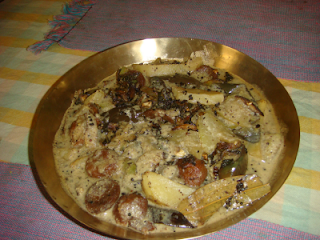Chingri or prawns are a favorite among most bengalees. We love prawns in any form – deep fried, shallow fried, in coconut milk gravy (malai curry), plain jhol/gravy of potato and tomato.
This preparation is done with prawns but with a twist. Those who really love it hot and spicy should try this out. And if you love the taste of coriander, then you might love this.
Here’s what you’ll need:
• Jumbo prawns / tiger prawns – deveined and de-shelled about 1 kg
• Tomato – 2 finely chopped
• Onion – 1 big finely chopped
• Ginger paste – 2 tsp
• Garlic cloves – 5 finely chopped
• Coriander leaves – 1 bunch finely chopped
• Turmeric – 3 tsp
• Red chili powder – 2 tsp
• Kashmiri kal mirch (Red capsicum powder) – 2 tsp
• Green chilies – 4 to 5 finely chopped
• Mustard oil – 2 cup
• Lemon juice – ½ lemon
• Salt to taste
Clean, devein and de-shell the prawns and mix in ½ lemon juice, ½ tsp of salt and ½ tsp of turmeric powder for 30 minutes.
Take a big bowl pour in the prawns. Now one by one add all the ingredients together to the prawns. Mix well. Keep a bit of coriander leaves and green chilies for garnishing.
Cover with a cling wrap or a lid and marinate for 2-3 hours.
Heat a kadai. Non-stick pan should work better. Once it is medium hot, pour in the entire ingredients. Now in a low to medium heat cook the entire prawns in the kadai. Cover occasionally and stir from time to time so that the masala does not get stuck at the bottom. With time, all the oil and other ingredients will start to mix together and soften.
It will taken 45 mins to 1 hr for the entire masalas to mix together. Add a little water if you want it to have gravy. But make sure it is not runny. You will notice, owing to all the tomatoes and kashmiri red chilies powder along with the coriander leaves and green chilies, you prawn curry will have a unique bright red and green look.
Once done, pour the entire curry in a bowl and garnish with coriander leaves and green chilies.
Serve hot. You can eat this spicy chingri / prawn curry with white rice or polau.

 Prawn
Prawn










